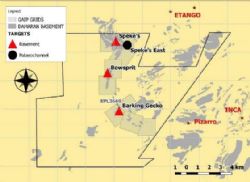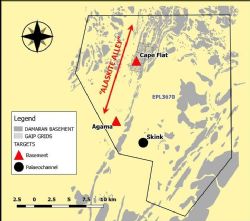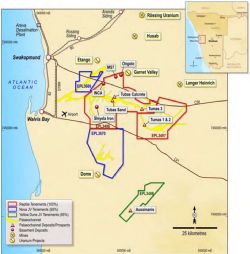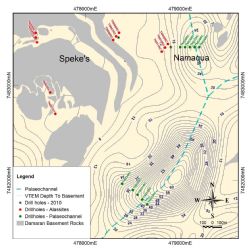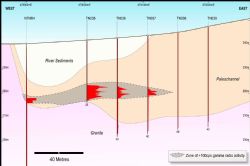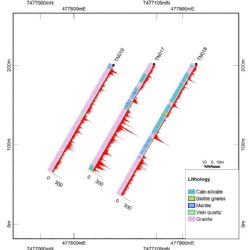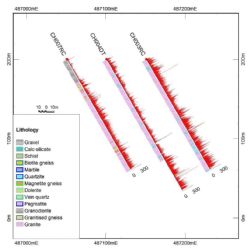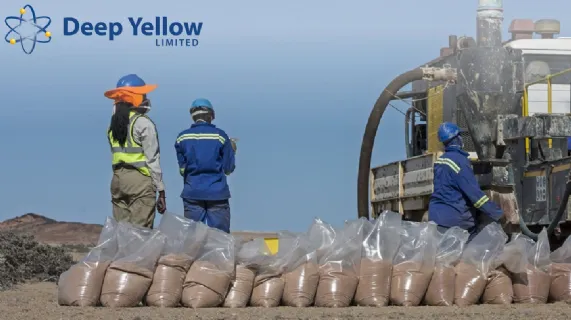
Scout Drilling Program for Nova Joint Venture Completed
Perth, Dec 22, 2017 AEST (ABN Newswire) - Deep Yellow Limited ( ASX:DYL) (
ASX:DYL) ( DYLLF:OTCMKTS) (Deep Yellow) is pleased to announce the completion of a 7,490m scout drilling program carried out on its Nova Joint Venture project, Namibia (Nova JV) where JOGMEC is earning a 39.5% interest. The drilling program started on 11 September and was completed on 13 December 2017.
DYLLF:OTCMKTS) (Deep Yellow) is pleased to announce the completion of a 7,490m scout drilling program carried out on its Nova Joint Venture project, Namibia (Nova JV) where JOGMEC is earning a 39.5% interest. The drilling program started on 11 September and was completed on 13 December 2017.
HIGHLIGHTS
- First pass exploration drilling campaign of 7490m was completed on EPLs 3669 and 3670.
- Targets included uranium mineralisation in surficial calcrete type within palaeochannels and alaskite and Skarn type in basement rocks.
- Best results in palaeochannels were reported in October from the northern part of EPL 3669, where promising uranium mineralisation was found in 3 adjacent holes.
- 24 of 37 drill holes testing basement targets intersected narrow uranium mineralisation in alaskite granites or skarn type lithologies.
Strongest intersections from Cape Flat include:
o 4.65 m at 220ppm eU3O8 from 33m;
o 1.2m at 327ppm eU3O8 from 68m; and
o 1.4m at 250ppm eU3O8 from 2.6m.
The overall drilling campaign was primarily designed to characterise the various targets that were defined from geophysics (using IP, EM, Magnetics and radiometrics) and ground mapping and, through this drill testing, determine applicability of methods to be used in future to isolate prospective zones. Ten basement targets and three newly identified palaeochannels were targeted for this initial investigation on EPLs 3669 and 3670. This first-pass drilling totalled 7,490m and involved 2 diamond core (DDH) and 82 reverse circulation (RC) drill holes of which 4 had a diamond core tail added. Figure 1 (see link below) shows the Nova JV tenements - EPLs 3669 and 3670. Prospect locations and drill hole locations are indicated in Figures 2, 4, 5 and 7 (see link below). Appendix 1 (see link below) lists all drill-hole information including associated eU3O8 values.
Palaeochannel Targets
The reinterpretation of a previously flown VTEM survey identified palaeochannels previously not known to occur on either of the tenements. Their geophysical similarities to other mineralised palaeochannels in the region indicated that these needed testing for calcrete associated uranium mineralisation.
Three drill sections involving 14 holes for 639m were completed to test the most northerly of these newly identified palaeochannels. As reported in ASX release dated 12 October 2017, drilling in this area encountered uranium mineralisation in three adjacent holes (TN035 to TN037 - see Table 1 in link below). These averaged 220ppm eU3O8 over 3.5m between depths of 18 to 23m as determined by fully calibrated Auslog down-hole gamma logging unit. An historic hole (NTNR4) drilled in 2010 located 100m to the west, targeting basement mineralisation, also showed uranium mineralisation in cover sediments. This new discovery was renamed the Namaqua Prospect (formerly Speke's East). The Namaqua channel was further tested by 2 drill lines 1.5 and 2.5 km to the south/south-west of the Namaqua discovery where no uranium mineralisation was encountered.
Figure 2 (see link below) shows the drill hole locations, interpreted palaeochannel and the Namaqua Prospect in the north of EPL 3669. Figure 3 (see link below) shows a cross-section of the holes drilled through the mineralised channel.
All drill holes testing palaeochannels at the Namaqua, Goanna and Skink targets are detailed in Appendix 1 Tables 1 and 2 (see link below).
The palaeochannel target drilled at Goanna in EPL 3669 (see Figure 4 in link below for drill hole locations) did not identify uranium mineralisation.
At Skink on EPL 3670 4 drill lines totalling 511m (see Figure 5 in link below for drill hole locations) tested an interpreted complex palaeochannel system associated with some surface radiometric anomalies and uranium in soils identified by previous explorers. Although calcrete was identified in the deeper parts of the palaeochannel system no uranium mineralisation was identified in these sediments.
Basement Targets
Ten targets in 4 areas were identified from ground geophysics which indicated potential for uranium mineralisation in the basement rocks. A total of 37 drill holes for 6134m were drilled on these targets. This involved 602m of core from 2 diamond drill holes and 4 diamond core tails and 5532m of RC drilling. Equivalent uranium values were determined from the fully calibrated Auslog down-hole gamma logging unit. These holes are listed in Appendix 1 Table 2 (see link below) along with other drill hole information.
In the north of EPL 3669 at Speke's and Bowsprit, drilling intersected generally fine-grained quartzo-feldspathic biotite rich rocks associated with pyrite (iron sulphite) rich, quartz carbonate veined lithologies. Minor visible copper mineralisation was also observed. Narrow uranium mineralisation was also intersected in 8 of the16 holes drilled on this target. There appears to be a correlation between elevated down-hole gamma counts, high pyrite content and high vein density indicating a hydrothermal nature of the uranium mineralisation and this will be further investigated. Further south, at Barking Gecko, uranium mineralisation is associated with alaskitic granite intrusions and uranium intersections, although still narrow, become more widespread as all three RC holes (TN017,18,19) are mineralised. Figures 2 and 4 (see link below) show the drill hole locations and Figure 6 (see link below) shows a cross-section from Barking Gecko.
On EPL3670 geophysical ground work identified a 400 to 500m wide, 3.5km long north-northeast trending zone of radiometric anomalism flanked on the east and west sides by chargeability anomalies identified by Gradient Array and Pole Dipole IP surveys. This feature is parallel to the regional "Alaskite Alley" trend which contains all the major basement related uranium deposits in the region. RC and diamond drilling at Cape Flat included 18 holes of which 12 showed uranium anomalism of greater than 100ppm eU3O8. The drilling identified various sheet like, partly sheared granite intrusions which, on occasion, showed alaskite characteristics. Uranium mineralisation of greater than 100ppm eU3O8 was intersected both in narrow peaks and in thicker intersections ranging 2 to 14m in width. Figure 7 (see link below) shows the drill hole locations superimposed over the uranium contours of a ground spectrometer survey and Figure 8 (see link below) shows a cross-section drilled through the central anomalous zone at 7445700N. Drill hole details and equivalent uranium intersections greater than 100ppm eU3O8 are listed in Appendix 1 Tables 1 and 2 (see link below).
To the south, the Cape Flat anomalous zone is covered by extensive colluvium which blankets all radiometric response. Although 8km to the south-south-west, surface radiometric anomalism occurs in an area where some minor sub-crop occurs within the colluvium cover. Airborne magnetics suggests that this prospective zone extends another 2km south-south-west towards the EPL boundary.
All basement uranium mineralisation will be assayed for U3O8 and various trace elements, Whole rock analysis is planned to characterise the various mineralised rocks and granite intrusions.
Conclusions
Further assessment of the data collected during this drilling campaign is required. Geochemical assay results are still being awaited. For the next field season detailed ground radiometric work and geological mapping will be undertaken to better characterise the anomalous areas that have been identified to date. Other geophysical methods may also be applied to better define targets for drilling.
The indication that previously unexplored (and unknown) palaeochannels are fertile carrying uranium mineralisation, as identified in 3 adjoining holes at Namaqua, is regarded as a very positive development. Although the two sections drilled 1.5km and 2.5km further to the south of this mineralisation did not encounter uranium mineralisation, the identification of calcrete associated mineralisation within the palaeochannels in the Nova JV area is considered significant as this has expanded the prospectively of the extensive system of palaeochannels that has been identified. Further drilling is planned in 2018 to explore the extent of the mineralisation at Namaqua and to evaluate the potential of the newly identified prospective palaeochannels on EPLs 3669 and 3670 which remain untested.
The exploration of the basement targets identified a promising zone of uranium anomalism at Cape Flat. Although grade and thickness of the mineralisation encountered is of a low level it indicates a mineralising event has occurred. However, the mineralisation may improve further toward the south where the prospective zone is blanketed by alluvium cover and this possibility will be tested in 2018. This southern extension of Cape Flat will be explored by geochemical methods and/or shallow bedrock drilling to isolate specific targets for follow up RC drilling.
To view tables and figures, please visit:
http://abnnewswire.net/lnk/0F1WON70
About Deep Yellow Limited
 Deep Yellow Limited (ASX:DYL) (OTCMKTS:DYLLF) is successfully progressing a dual-pillar growth strategy to establish a globally diversified, Tier-1 uranium company to produce 10+Mlb p.a.
Deep Yellow Limited (ASX:DYL) (OTCMKTS:DYLLF) is successfully progressing a dual-pillar growth strategy to establish a globally diversified, Tier-1 uranium company to produce 10+Mlb p.a.
The Company's portfolio contains the largest uranium resource base of any ASX-listed company and its projects provide geographic and development diversity. Deep Yellow is the only ASX company with two advanced projects - flagship Tumas, Namibia (Final Investment Decision expected in 1H/CY24) and MRP, Western Australia (advancing through revised DFS), both located in Tier-1 uranium jurisdictions.
Deep Yellow is well-positioned for further growth through development of its highly prospective exploration portfolio - ARP, Northern Territory and Omahola, Namibia with ongoing M&A focused on high-quality assets should opportunities arise that best fit the Company's strategy.
Led by a best-in-class team, who are proven uranium mine builders and operators, the Company is advancing its growth strategy at a time when the need for nuclear energy is becoming the only viable option in the mid-to-long term to provide baseload power supply and achieve zero emission targets.
Importantly, Deep Yellow is on track to becoming a reliable and long-term uranium producer, able to provide production optionality, security of supply and geographic diversity.
| ||
|



